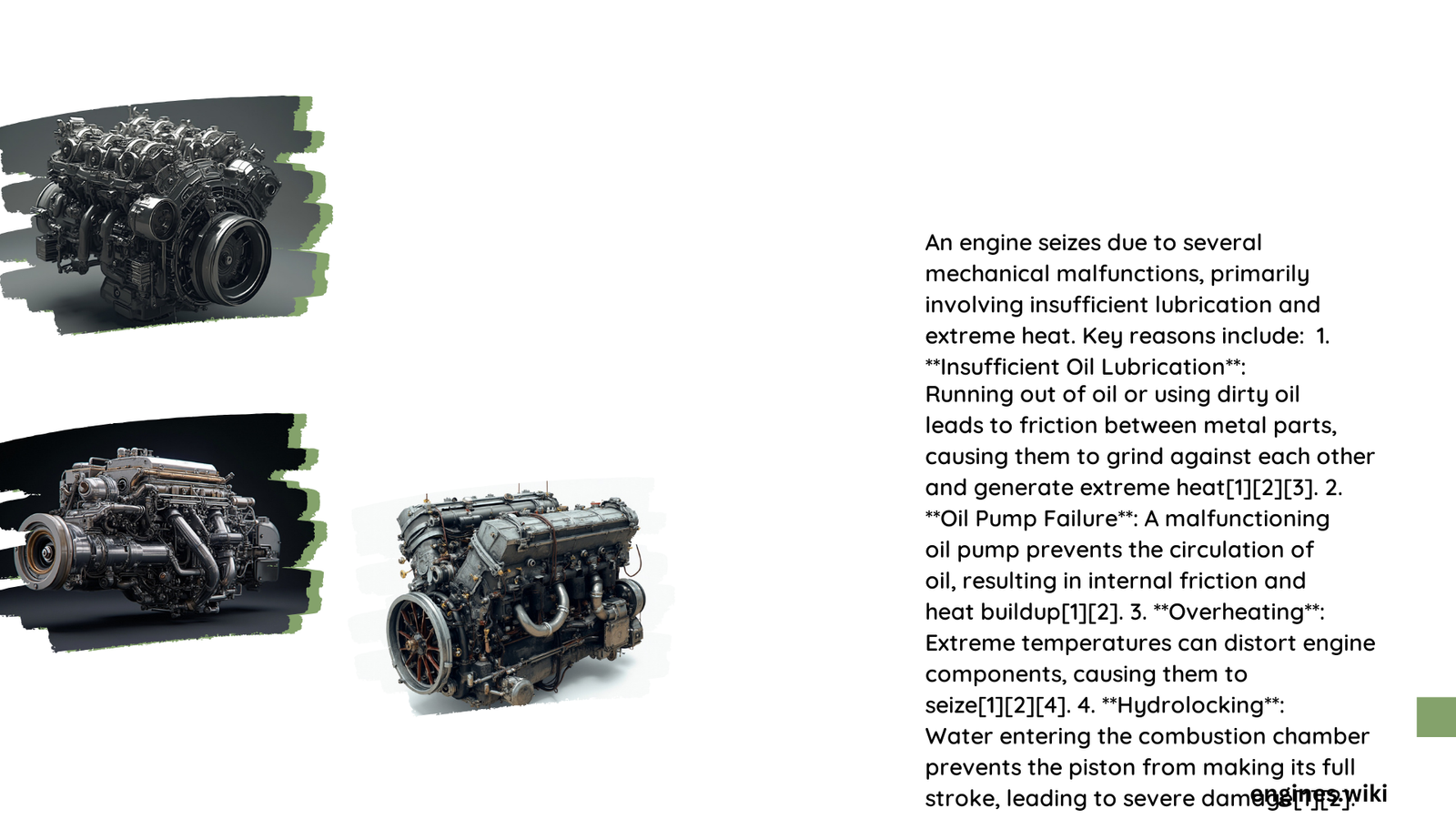Engine seizure is a catastrophic failure that occurs when internal components stop moving, often due to excessive friction, heat, or lack of lubrication. This can lead to severe damage, requiring costly repairs or complete engine replacement. Understanding the causes of engine seizure is crucial for vehicle owners to prevent such devastating outcomes and maintain their engines’ longevity.
What Are the Primary Causes of Engine Seizure?
Engine seizure can result from various factors, but the most common causes include:
- Low oil pressure
- Overheating
- Inadequate lubrication
- Mechanical failures
Let’s delve deeper into each of these causes and their implications.
How Does Low Oil Pressure Lead to Engine Seizure?
Low oil pressure is a critical factor in engine seizure. When oil pressure drops, it indicates insufficient oil circulation, leading to:
- Increased friction between moving parts
- Excessive heat generation
- Metal-to-metal contact
Most engines require a minimum oil pressure of:
– 10-20 PSI at idle
– 30-60 PSI at higher engine speeds
If the oil pressure falls below these thresholds, severe engine damage can occur rapidly. For instance, if oil pressure drops to 0 PSI, the engine can seize within minutes due to lack of lubrication.
What Causes Low Oil Pressure?
Several factors can contribute to low oil pressure:
-
Oil viscosity issues: Using the wrong oil viscosity can affect pressure. Thinner oil might not build sufficient pressure, while thicker oil can create too much resistance.
-
Oil degradation: Not changing oil regularly leads to sludge formation, clogging passages and restricting oil flow.
-
Clogged oil filters: A clogged filter can restrict oil flow and reduce pressure. It’s crucial to change the oil filter with every oil change.
-
Oil pump failure: A malfunctioning oil pump can’t maintain proper pressure, leading to inadequate lubrication.
-
Worn engine bearings: Excessive wear in engine bearings can cause oil pressure to drop.
How Does Overheating Contribute to Engine Seizure?
Overheating is another significant factor that can lead to engine seizure. When engine temperature exceeds the critical range, it can cause:
- Engine oil to lose viscosity and effectiveness as a lubricant
- Warping of metal parts (cylinder head, engine block, pistons)
- Expansion of metal components, reducing clearances
Critical overheating ranges typically start above 230°F (110°C), with prolonged exposure above 250°F (121°C) causing significant damage.
Which Engine Components Are Most Susceptible to Overheating?
| Component | Effect of Overheating |
|---|---|
| Pistons | Can seize or melt due to excessive heat |
| Bearings | Can fail due to lack of lubrication and increased friction |
| Cylinder Head | Can warp or crack |
| Engine Block | Can crack or warp |
What Role Does Inadequate Lubrication Play in Engine Seizure?
Inadequate lubrication occurs when the oil film between moving parts breaks down, often due to:
- High temperatures
- Fuel flooding
- Insufficient oil supply
This breakdown can happen even if there’s sufficient clearance between the cylinder and piston. The surfaces of the piston, piston rings, and cylinder running surface then rub against each other without lubrication, causing seizure.
Where Are the Common Lubrication Failure Points?
Inadequate lubrication can occur at various points, including:
- Piston skirt
- Piston rings
- Cylinder running surface
- Piston top land (localized seizures)
- Piston ring sliding surfaces (score marks)
What Mechanical Failures Can Cause Engine Seizure?
Mechanical failures that can lead to engine seizure include:
-
Broken timing belt or chain: This can cause pistons to collide with valves, leading to seizure.
-
Thrown rod: A connecting rod breaking free can cause catastrophic engine damage.
-
Damaged crankshaft: A bent or broken crankshaft can cause the engine to seize.
-
Hydrolocked engine: Water entering the combustion chamber can cause hydrolock, leading to seizure.
-
Broken camshaft: A broken camshaft can disrupt valve timing, potentially causing piston-valve collision.
How Can Engine Seizure Be Prevented?

Preventing engine seizure involves regular maintenance and attentive driving:
-
Regular oil changes: Follow manufacturer recommendations for oil change intervals.
-
Use the correct oil: Always use the oil viscosity specified by the manufacturer.
-
Monitor oil pressure: Pay attention to oil pressure gauges or warning lights.
-
Keep an eye on temperature: Watch for overheating signs and address cooling system issues promptly.
-
Regular maintenance: Follow the recommended maintenance schedule for your vehicle.
-
Address unusual noises: Investigate and resolve any unusual engine noises promptly.
-
Avoid overloading: Don’t exceed your vehicle’s weight capacity or towing limits.
-
Proper warm-up: Allow your engine to warm up properly, especially in cold weather.
What Are the Consequences of Engine Seizure?
The consequences of engine seizure can be severe:
-
Costly repairs: Repair costs can range from $2,000 to $5,000 or more, depending on the extent of damage.
-
Engine replacement: In severe cases, a complete engine replacement may be necessary.
-
Vehicle downtime: Significant repair time can leave you without transportation.
-
Decreased vehicle value: A history of engine seizure can significantly reduce a vehicle’s resale value.
Understanding why an engine would seize is crucial for every vehicle owner. By recognizing the causes and implementing preventive measures, you can avoid the catastrophic consequences of engine seizure and ensure the longevity of your vehicle’s engine.
